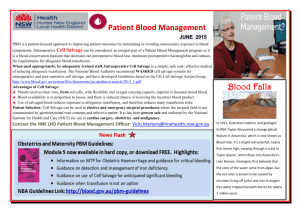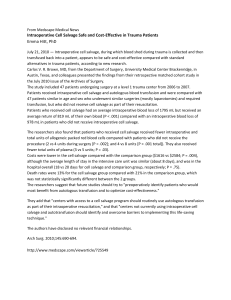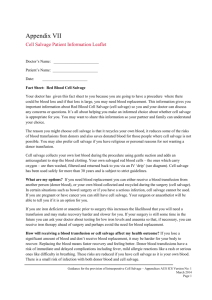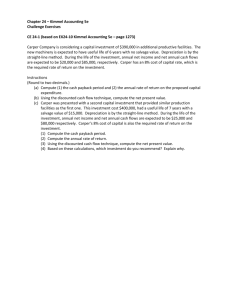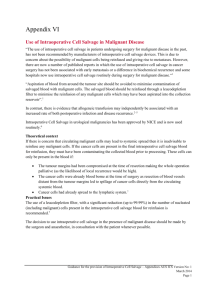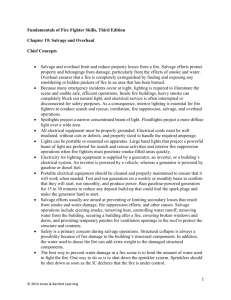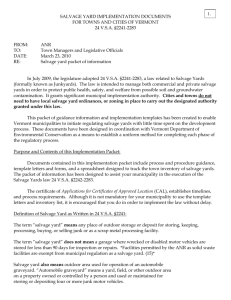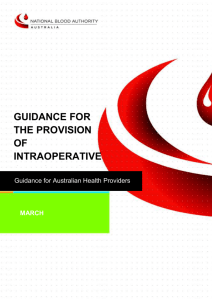Companion 18 PBM Guidelines
advertisement
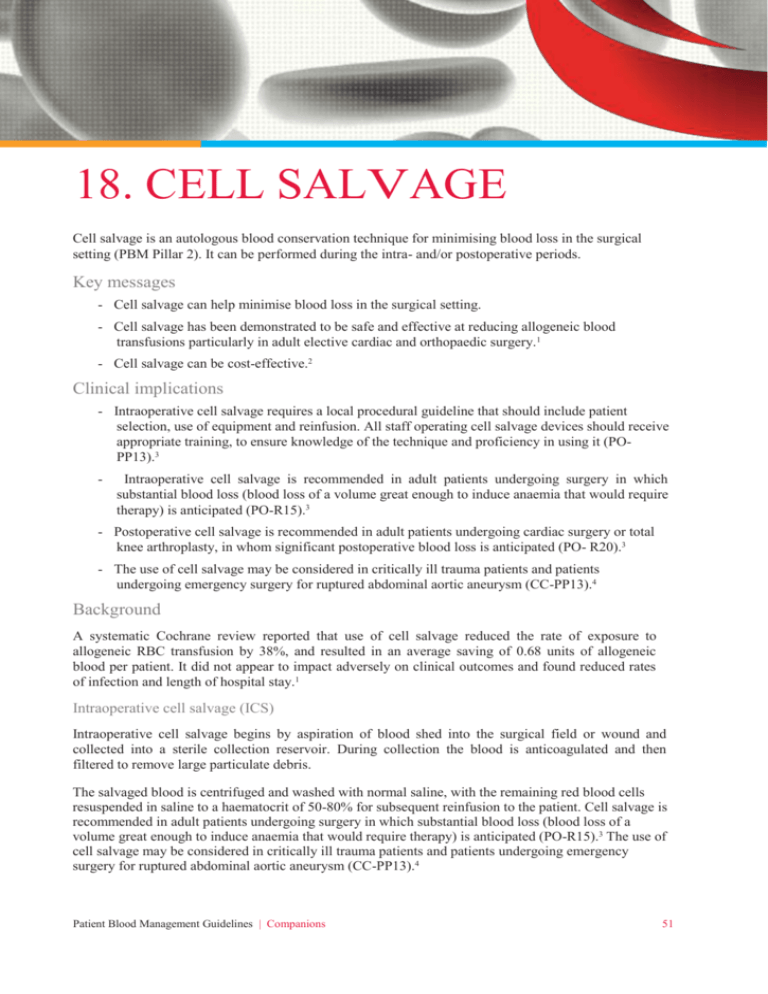
18. CELL SALVAGE Cell salvage is an autologous blood conservation technique for minimising blood loss in the surgical setting (PBM Pillar 2). It can be performed during the intra- and/or postoperative periods. Key messages - Cell salvage can help minimise blood loss in the surgical setting. - Cell salvage has been demonstrated to be safe and effective at reducing allogeneic blood transfusions particularly in adult elective cardiac and orthopaedic surgery.1 - Cell salvage can be cost-effective.2 Clinical implications - Intraoperative cell salvage requires a local procedural guideline that should include patient selection, use of equipment and reinfusion. All staff operating cell salvage devices should receive appropriate training, to ensure knowledge of the technique and proficiency in using it (POPP13).3 - Intraoperative cell salvage is recommended in adult patients undergoing surgery in which substantial blood loss (blood loss of a volume great enough to induce anaemia that would require therapy) is anticipated (PO-R15).3 - Postoperative cell salvage is recommended in adult patients undergoing cardiac surgery or total knee arthroplasty, in whom significant postoperative blood loss is anticipated (PO- R20).3 - The use of cell salvage may be considered in critically ill trauma patients and patients undergoing emergency surgery for ruptured abdominal aortic aneurysm (CC-PP13).4 Background A systematic Cochrane review reported that use of cell salvage reduced the rate of exposure to allogeneic RBC transfusion by 38%, and resulted in an average saving of 0.68 units of allogeneic blood per patient. It did not appear to impact adversely on clinical outcomes and found reduced rates of infection and length of hospital stay.1 Intraoperative cell salvage (ICS) Intraoperative cell salvage begins by aspiration of blood shed into the surgical field or wound and collected into a sterile collection reservoir. During collection the blood is anticoagulated and then filtered to remove large particulate debris. The salvaged blood is centrifuged and washed with normal saline, with the remaining red blood cells resuspended in saline to a haematocrit of 50-80% for subsequent reinfusion to the patient. Cell salvage is recommended in adult patients undergoing surgery in which substantial blood loss (blood loss of a volume great enough to induce anaemia that would require therapy) is anticipated (PO-R15).3 The use of cell salvage may be considered in critically ill trauma patients and patients undergoing emergency surgery for ruptured abdominal aortic aneurysm (CC-PP13).4 Patient Blood Management Guidelines | Companions 51 An example of a list of Surgical Procedures where intra-operative cell salvage presents significant benefit towards the management of peri-operative blood loss is available. (Link to Appendix II of NBA document). The major advantage of intraoperative cell salvage is the reduction in exposure to allogeneic blood transfusion and all its associated risks. In particular, clerical errors and immune-modulatory effects are mitigated. It has been shown to be cost-effective and associated with minimal complications.1,2,5 There are few contraindications, however intraoperative cell salvage is not recommended when bowel content or infected material is present in the surgical field.6 Intraoperative cell salvage requires a local procedural guideline that should include patient selection, use of equipment and reinfusion. All staff operating cell salvage devices should receive appropriate training, to ensure knowledge of the technique and proficiency in using it (PO-PP13).3 Post-operative Cell Salvage (PCS) Postoperative cell salvage involves collecting blood that is lost from the wound post-operatively into special autologous wound drains where it is filtered before being reinfused to the patient.6 Postoperative cell salvage should be considered in adult patients undergoing cardiac surgery or total knee arthroplasty, in whom significant postoperative blood loss is anticipated (PO-R20).3 References 1. Carless PA, Henry DA, Moxey AJ, O’Connell D, Brown T, Fergusson DA. Cell salvage for minimising perioperative allogeneic blood transfusion. Cochrane database of systematic reviews (Online) [Internet]. 2010;(4):CD001888. 2. Kozek-Langenecker SA, Afshari A, Albaladejo P, Santullano CA, De Robertis E, et al. Management of severe perioperative bleeding: guidelines from the European Society of Anaesthesiology. Eur J Anaesthesiol. 2013;30:270382. 3. National Blood Authority Patient blood management guidelines: Module 2 – Perioperative. Australia, 2012. 4. National Blood Authority Patient blood management guidelines: Module 4 – Critical Care. Australia, 2013. 5. Murphy GJ, Rogers CS, Lansdowne WB, Channon I, Alwair H, Cohen A, Caputo M, Angelini GD..Safety, efficacy, and cost of intraoperative cell salvage and autotransfusion after off-pump coronary artery bypass surgery: a randomized trial. [Internet]. The Journal of thoracic and cardiovascular surgery. 2012 p. 20–8. 6. UK Cell Salvage Action Group. Intraoperative Cell Salvage education workbook. 2008. Additional Resources - 52 Guidance for the Provision of Intraoperative Cell Salvage – http://www.blood.gov.au/ics Patient Blood Management Guidelines | Companions

